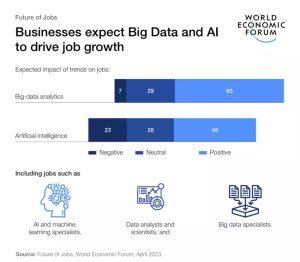From the “robot revolution” to algorithm Armageddon?
While technology continues to pose both challenges and opportunities to labour markets, employers expect most technologies to contribute positively to job creation.

The fastest growing roles are being driven by technology and digitalization. Big data ranks at the top among technologies seen to create jobs, with 65% of survey respondents expecting job growth in related roles. The employment of data analysts and scientists, big data specialists, AI machine learning specialists and cybersecurity professionals is expected to grow on average by 30% by 2027. Training workers to utilize AI and big data will be prioritized by 42% of surveyed companies in the next five years, ranking behind analytical thinking (48%) and creative thinking (43%) in importance. Digital commerce will lead to the largest absolute gains in jobs: approximately 2 million new digitally enabled roles are expected, such as e-commerce specialists, digital transformation specialists, and digital marketing and strategy specialists.
At the same time, the fastest declining roles are also being driven by technology and digitalization, with clerical or secretarial roles including bank tellers, cashiers and data entry clerks expected to decline fastest.
The Future of Jobs Report 2023 suggests that tasks are seen as no more automated now than they were three years ago when the report was last published. About a third of tasks (34%) are currently automated, just 1% above the 2020 figure. Surveyed companies also revised down their expectations for further automation, to 42% of tasks by 2027, compared to 2020 estimates of 47% of tasks by 2025.
But while expectations of the displacement of physical and manual work by machines has decreased, reasoning, communicating and coordinating – all traits with a comparative advantage for humans – are expected to be more automatable in the future. Artificial intelligence, a key driver of potential algorithmic displacement, is expected to be adopted by nearly 75% of surveyed companies and is expected to lead to high churn – with 50% of organizations expecting it to create job growth and 25% expecting it to create job losses.





